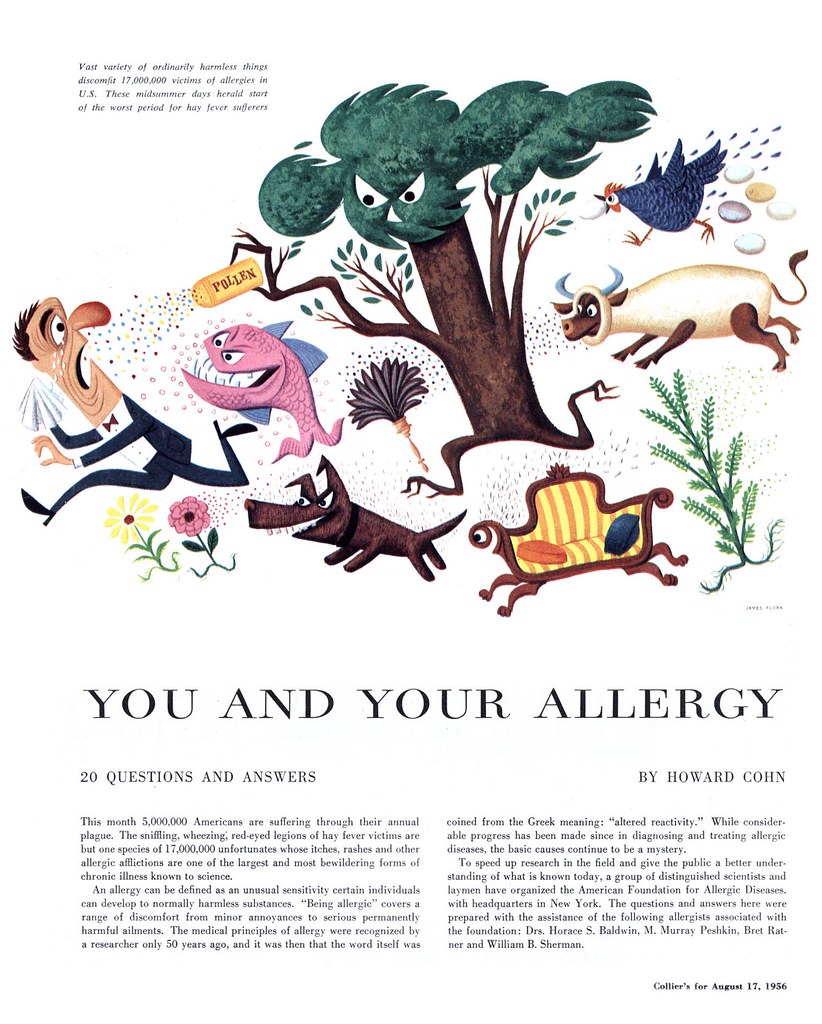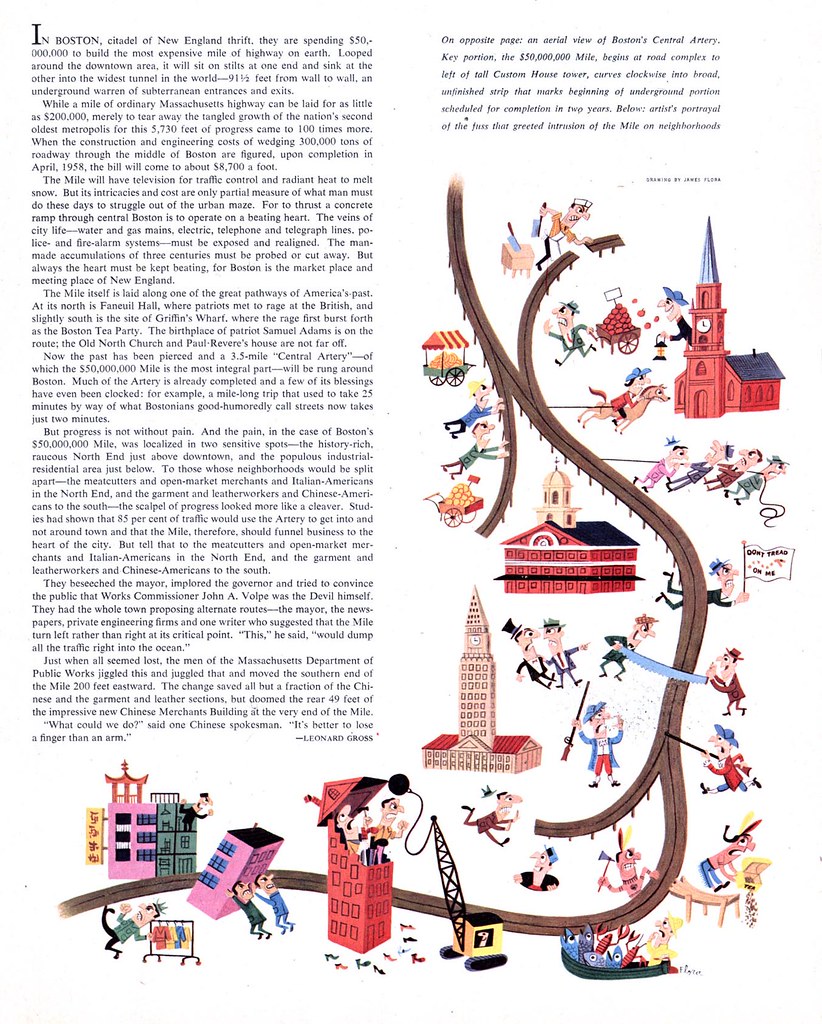
I was in the 8th grade [ca. 1927]. I always drew pictures and they used to lend me to the high school to draw pictures for the high school paper. I guess the principal really thought I was going to do something someday, because I was a pretty bright kid. I didn’t start going downhill until high school. As soon as I met girls, my grades went to pieces. A phrenologist came to town and evidently he gave the principal a free pass and she took me there. I remember being in this hotel room and this phrenologist feeling my head! And then he said to her, "This boy’s gonna be a commercial artist." I didn’t know what a commercial artist was. Never heard the term before.
-- Jim Flora to Angelynn Grant (interview), November, 1990
Perhaps the tale is apocryphal. Flora was, after all, a storyteller. But if the above incident really happened (the discredited "science" of phrenology retained an antediluvian flock in the early 20th century), it either speaks well for determining vocation by the bumps on a kid's noggin -- or it was a lucky guess.
After Flora left the Art Academy of Cincinnati in 1939, he cultivated a modest clientele in his hometown, mostly corporate and retail accounts. "I began to do work for Procter & Gamble," he recalled. "Dull, terrible work for point-of-sale things. I would draw people washing diapers, things like that." In the late 1940s, while employed by Columbia Records -- and dissatisfied that he had been promoted away from graphic design -- he began accepting outside assignments. Flora's freelance career took off in the early 1950s after his Mexican caper. Because his mortgage was at stake, he stood at the crossroads of art and commerce. An artist pleases himself; a commercial artist must please a client, and by extension the marketplace. Flora surely faced pressures to compete and to indulge art directors and sales brass, whose own mortgages hinged on the outcome of his graphic problem-solving; consequently, some assignments were less art and more like -- jobs. In a 1998 interview with Steven Guarnaccia, Flora admitted, "When I was freelancing, I had to do a lot of work I wish I hadn’t had to do."

Here are two examples which may or may not have been fun to do, but let's agree they're fun to look at. "You and Your Allergy" appeared in Collier's, August 1956, and "Boston's $50 Million Mile" ran in Collier's, May 1956. No need for graphic forensics. Just admire the master's handiwork.
It's always nice to see Jim's work heralded. He was a great artist and a groovy guy. One small correction: the interview referenced here took place in November of 1990. You can read the interview in it's entirety on my site.
ReplyDeleteMy apologies to Angelynn on both counts. (The error and the omission have been corrected in the original post.) As is obvious from the date of her interview, Angelynn was way ahead of the Flora rediscovery curve. Though I owned several Flora LP covers (purchased at tag sales strictly for the artwork), I didn't learn about the artist until 1997, and my awareness came about through JD King.
ReplyDeleteAngelynn provided Barbara and me with three original 1950s LP cover sketches to reproduce in The Mischievous Art book. I seem to recall (she can verify, deny, or elaborate) that Flora offered them as keepsakes during her visit, but she was too in awe of him to accept these historic treasures. After she left, he mailed them to her. Such was the man's generosity. He lent me dozens of original RCA Victor and Columbia album proof sheets to scan for the Flora web gallery, then insisted I keep his duplicates. In the final years of his life, he seemed concerned about "burdening" his family with his artistic estate. A number of artifacts (we have no idea how many) were dispersed to fans and collectors -- some sold, some given away. We're trying to track them down to catalog as much as possible. If you have pre-1970 Flora work (paintings, sketches, prints, published material), please contact me at: info@JimFlora.com.
Actually, I wrote to Jim requesting an interview and not only did he write back to say yes, he sent the packet of sketches and proof sheets, all without having met me.
ReplyDeleteWe may have had a phone call in between my first letter and his sending the packet, but my memory isn't exact. Somewhere I have all of his letters and will look at them some day soon, not just to create a timeline, but more to see once again the imaginative and playful way he decorated the "To" and "From" sections on both the letter envelopes and the packet wrapping. At one point, I mentioned to him how much I loved seeing his letters because of how he decorated them and he said he thought that it helped them reach their destination better -- the Post Office gave them special attention. I have used that method myself many times since. And I always think of him when I decorate my "To" and "From" fields.
To continue the "giving props," Jim's work first came to my attention in the 1980s, mostly from seeing 78 and LP covers in the collection of my friend Jack Woker who owns Stereo Jacks record store in Cambridge, Mass. We put a little exhibit up in the back of the store around 1988, one of a series on distinctive cover designs and designers.
Whenever copies would end up in the bins for sale at the store, I would scoop them up. I did research on several jazz cover designers (e.g., Jim, Paul Bacon, David Stone Martin, Tom Hannon, John Hermansader, Reid Miles, etc.) at a few libraries around here, most especially at Harvard's Widener Library. The information trail quickly led to the extensive research done in the area of jazz album cover design by Martina Schmitz, who's PhD thesis (in German) could be special ordered from the Munich publisher Scaneg. She also published an article in the March/April 1986 issue of Print magazine.
Around this time, I met a woman illustrator who was a contemporary of Jim's and who had known him in NYC. I've forgotten her name, but it's somewhere in my notes. It was this meeting that spurred me to contact him at his home in Rowayton in 1990.
And I'll always be glad that I did and always be grateful for his kind attention and warm encouragement and our cheerful and lively conversations about art, design, and jazz.
Contact an online Custom Paper Writing Services, and they deliver entirely Custom Research Papers upon request. Note that the content of Best Online Essay Writing Services is unique and non-plagiarized.
ReplyDelete